It starts with a simple question: How do you create a profitable business?
There are countless paths—but most boil down to two core models every business follows.
The traditional method is to build a product first and then find customers to buy it.
The second method—far more popular in recent years—starts by building an audience first.
As you might have guessed, this audience-first model means you identify real people, learn what they struggle with, and then create something you already know they want.
Both approaches work, and both come with trade-offs.
With the product-first model, you can start generating revenue quickly—but you also risk weak product-market fit and building something too few people actually want.
With the audience-first model, you deliberately grow an audience—most effectively with content marketing—before you sell anything.
You earn attention in a specific niche, surface that audience’s biggest problems, and build trust along the way.
Then you ship a solution tailored to those problems—often leading to exceptional conversion rates because the product feels made for them.
The trade-off: it usually takes months to monetize meaningfully.
So which model is “best”?
The honest answer: neither is universally better.
Both models have built massive businesses. The right choice depends on your timeline, skills, capital, and appetite for risk.
If you can delay revenue while you build a reputation and a readership, the audience-first approach is the safer way to reduce product risk (though there are never guarantees).
If the audience-first method resonates with you, you’ll love what’s next.
Below, we’ll walk through seven practical steps to build an audience with content and then create a product they’re excited to buy.
Step #1 – Choose a customer in markets that actually buy
You almost never build a great audience by accident.
It takes a deliberate plan to find the right people and publish content they genuinely value.
Start with one rule: pick an audience you truly care about.
You’ll be creating useful content and tools for months before you see a direct payoff. Caring about the people you serve is what keeps you consistent.
It’s really hard to stay motivated if you’re creating content for people you don’t care about.
We love marketing, so we publish marketing advice for marketers, founders, and small-business owners.
Caring about our audience is what motivates us to keep publishing even when revenue isn’t immediate.
Make a short list of audiences you’d be happy to help for months on end—even with no guaranteed return.
You may find a few viable options, but you’ll pick one now and go deep. Get specific (find your niche).
For example, if you like marketing, don’t stop at “marketers.” Narrow to small-business owners adopting content marketing for the first time.
That level of focus lets you solve concrete problems. You can always expand later.
But avoid one big mistake:
Don’t build an audience of people who fundamentally don’t buy things.
For instance, an audience of strict minimalists aims to reduce consumption. They can still buy—but selling to them is uphill.
Contrast that with home decorators, who actively seek new items and ideas. If you build something great for them, sales aren’t the bottleneck.
How do you know if an audience is commercially viable?
Validate that they already buy products.
This is basic validation.
Look for evidence that your audience buys a healthy number of products—competition is a positive signal.
Competition means there’s a pie worth fighting for.
And in most niches, plenty of products aren’t great. If you can ship something clearly better, you’ll stand out.
If there’s zero competition, it often means the market doesn’t buy. In that case, find a different audience.
Validate demand across three product types.
Product type #1 – Physical products: Some audiences primarily buy physical goods—often hobbyists.
Say you want to help swimmers.
Common sense suggests they need gear they can actually use.
Head to Amazon to gauge demand for physical products.
Search a few audience-relevant keywords to review the top results. For example: swimming equipment:
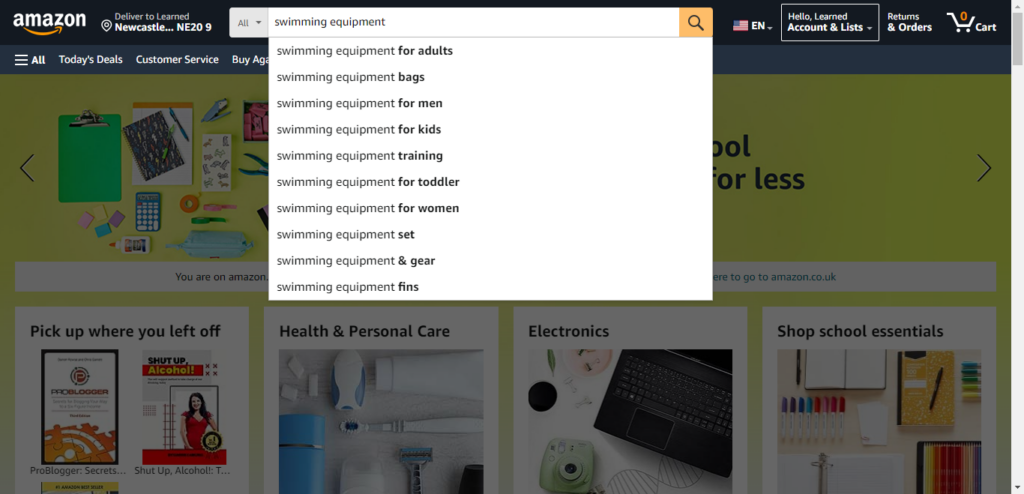
The upside of picking an audience you know is that identifying what they buy gets a lot easier.
Look for two things:
- Visible demand (strong sales signals)
- Healthy prices (a mix of $10+ items, not just ultra-cheap)
To estimate demand, scan review counts on top products. 100+ reviews typically signals meaningful sales volume.
Use judgment for sensitive categories where buyers rarely leave reviews. The goal is to assess real-world demand, not hit a magic number.
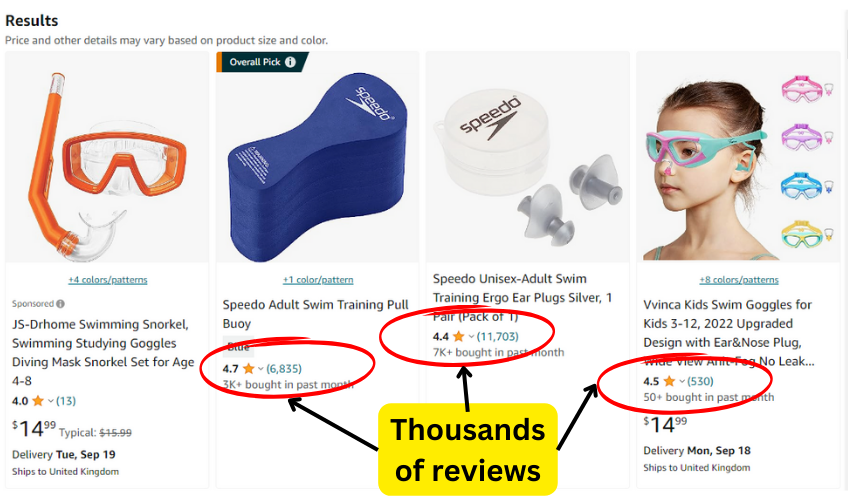
In our example, several top products have substantial review counts, indicating strong demand for swimming gear.
Prices also start around $10 with plenty of higher-ticket items—another sign the audience values more than “cheapest possible.”
Product type #2 – Informational products: Many audiences buy education—e-books, courses, and guides.
You can also validate demand for information products via Amazon.
Search your topic in the Kindle Store, or browse via categories.
A search for swimming shows titles with dozens to hundreds of reviews—solid indicators for books (which tend to get fewer reviews than physical goods).
Identify at least a handful of consistent sellers.
You can also open a product page and check its Kindle Best Sellers Rank for additional context.
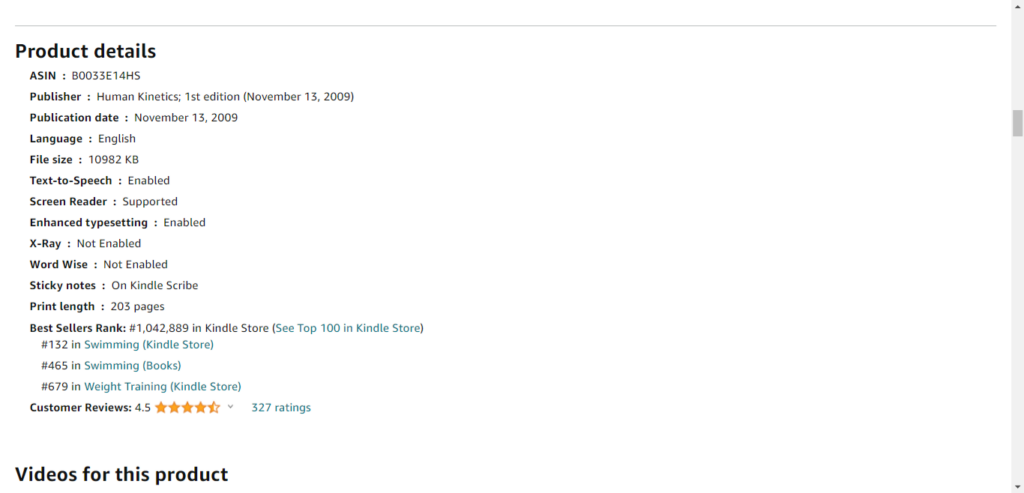
The Kindle marketplace doesn’t represent the entire audience, so you’re simply looking to confirm that there is real demand.
There are tools like KDSpy that estimate sales for specific keywords.
If you can’t find signs of life here, your audience may not value digital education enough to buy it.
In our swimming example, information demand looks modest—present, but not overwhelming.
Product type #3 – Software products: Web apps and tools are common purchases for audiences who live online—marketers, freelancers, designers, DJs, and more.
They do most of their work on computers, so they buy tools that help them work faster or better.
Search Google for your audience + tools to gauge the landscape.
If results show no relevant tools and no ads, that suggests low commercial intent for software in that niche.
Now compare that to a clearly commercial audience like marketers.
For example, search for keyword tracking tools and you’ll usually see ads, carousels, and comparison features—strong signals of buyer demand:
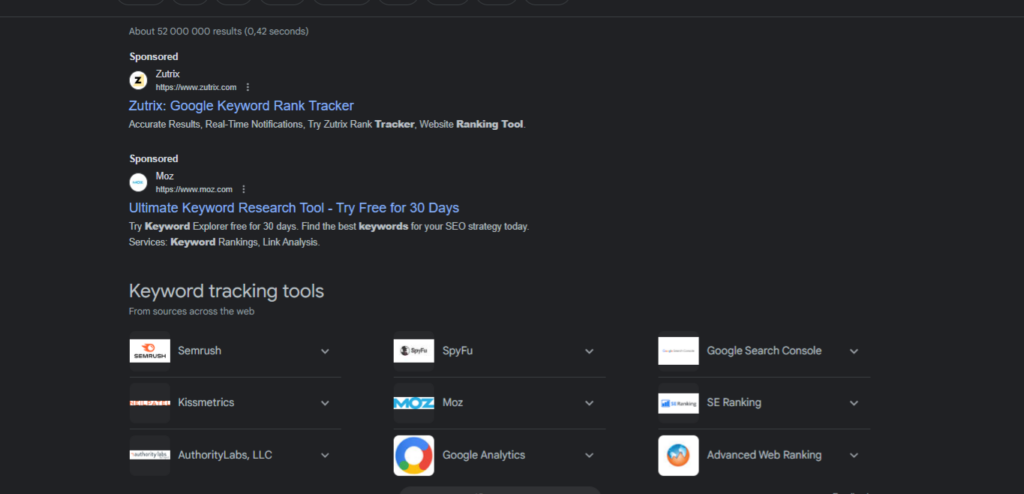
That kind of “red carpet” treatment—ads everywhere and recognizable brand logos—usually means a mature, high-intent market.
Try a few adjacent queries your audience might search to round out your view of demand.
After validation, narrow it down: If none of the three product types shows demand, pick a different audience. If only one does, ask yourself whether you’d be happy building that type of product later.
Most people lean one way—some love the idea of a SaaS, others prefer physical products or courses. There’s no single right answer.
Best case: all three show demand. That gives you options for what to build when you’re ready.
Once you’ve validated a few audiences, cross off the non-starters and commit to one you’re excited to pursue.
Step #2 – Put the audience first—before the content
The audience comes before the product—and before your first blog post.
Unless you already understand your target reader deeply, pause to research basic demographics and psychographics.
Here’s how.
Start with demographics: Demographics are the quantifiable traits of your audience.
Common examples include:
- location
- age
- gender
- income
- education level
- religion
- ethnicity
- marital status
- number of children
Define the demographic traits that actually matter for your niche.
For a high-heels blog, gender likely matters. For marketers or chefs, it probably doesn’t.
Decide which variables are relevant for your audience and ignore the rest.
One way to find demographic signals is with Google Analytics—especially if you already have a site with traffic.
In Google Analytics 4, use the Demographics reports to see your own audience’s age, location, language, gender, and interests. For adjacent or competitor signals, supplement with platform data—e.g., Google Ads’ Insights and Audience Manager > Audience Insights, or Meta Business Suite’s audience insights—plus any third-party tools you trust.
The purpose here is to define a reader persona that guides topic choices, formats, and tone.
Continue with psychographics: Psychographics describe what your audience thinks, believes, and prefers.
Consider questions like:
- Why do they want to learn about (your niche)?
- How important is (your niche) to them—hobby or job critical?
- How do they prefer to learn (video, text, audio) and on which devices?
- What questions come up repeatedly in (your niche)?
- How experienced are they—beginners, intermediates, or advanced?
Draft concise answers to each. You’re building a mental model of how your readers think.
This profile sets up your next move: positioning.
Step #3 – Positioning: win by being the obvious choice for someone
By now, you’ve chosen an audience that buys.
That means you’ll have competitors.
Don’t panic.
You can still stand out—by choosing smart positioning.
What’s positioning? It’s how you want your audience to associate your brand within their interests—your angle.
Here’s a quick example.
Suppose you target social media marketers.
There’s one snag…
If you publish general “social media tips,” you’ll be invisible in a sea of big sites.
Why? Because people already associate social media education with brands like Quick Sprout and Social Media Examiner.
When they want general advice, they go to the names they already know.
But big sites have blind spots. Every authority does.
They serve the broad market; they can’t serve every segment perfectly.
Some readers want bite-sized tips. Others want deep dives on a single network—say, Pinterest.
Large publishers cover everything, which isn’t ideal for readers who want one specific flavor.
See where this is going?
You can stand out by serving a specific slice better than anyone else.
Position yourself to create content the way your chosen segment prefers—something they can’t easily get elsewhere.
Example: become the go-to source for quick, tactical Pinterest marketing tips.
When someone wants fast Pinterest tactics, they won’t think “general marketing blog”—they’ll think of you.
The upside is loyalty. When readers feel like your content is tailor-made for them, they read, share, and stick around.
Find your position with a matrix: To choose an angle, use a positioning matrix.
A positioning matrix is a simple plot.
Pick a factor for the X-axis and another for the Y-axis. Plot competitors to reveal open space.
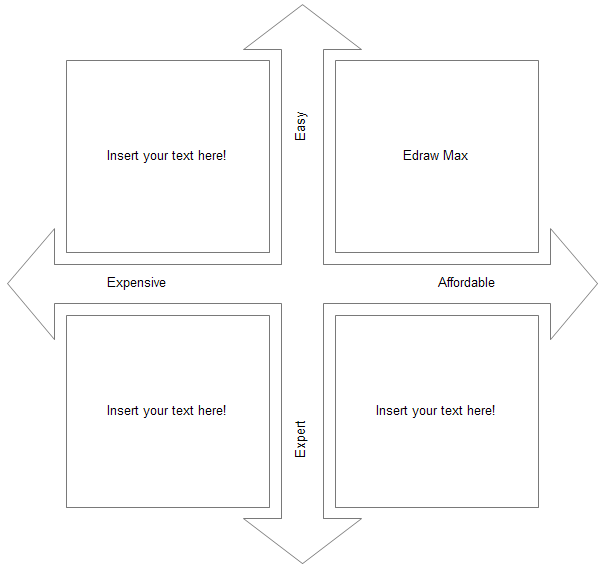
Step #1 – Identify differentiators: Brainstorm attributes your audience values.
A differentiator is anything readers can like or dislike.
Some want advanced content; others need beginner-friendly guides. Here, the differentiator is difficulty.
Common differentiators include:
- Difficulty: Easy vs. Hard
- Detail: Brief vs. Step-by-step
- Type of content: Mostly text vs. Image-heavy vs. Rich media
- Experience level: Beginner vs. Professional
- Cost: Cheap vs. Expensive
- Length: Short vs. Long
There are more—add any that matter in your niche.
Step #2 – Identify competitors: List 8–12 sites your audience already reads.
If you’re new to the niche, start with a quick Google pass.
Top social media marketing blogs.
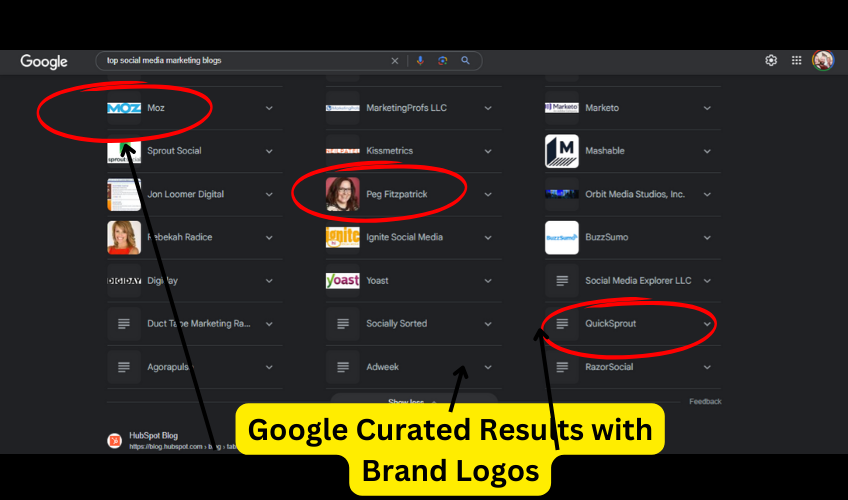
Google often highlights recognized publishers with site names and favicons—use these as a starting point, then add niche sites your audience mentions in forums, comments, newsletters, and communities.
Ideally, you want a list of about 10 competitors—Google will surface several, and you can round out the list from industry roundups and what your readers already follow.
Step #3 – Plot your competitors: Choose two differentiators from above.
Create a simple matrix with those as your axes. Paper, spreadsheet, drawing tool—anything works.
It should look like this:
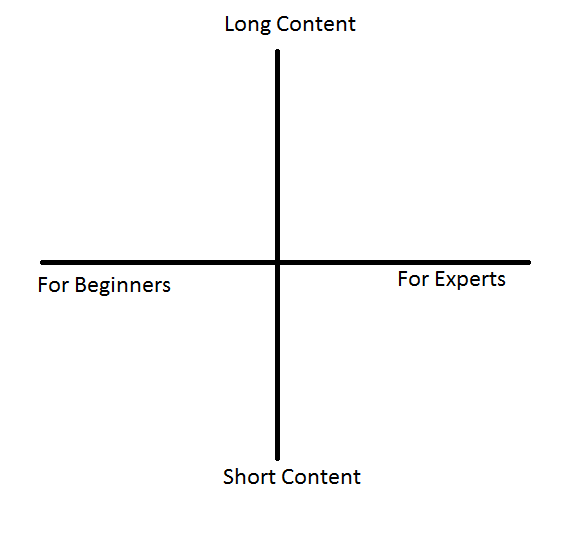
Review each competitor and place them where they fit.
For example, long, advanced articles sit toward “Long” and “Hard.” Short, beginner primers land in the opposite quadrant.
Plot them all to visualize the gaps:
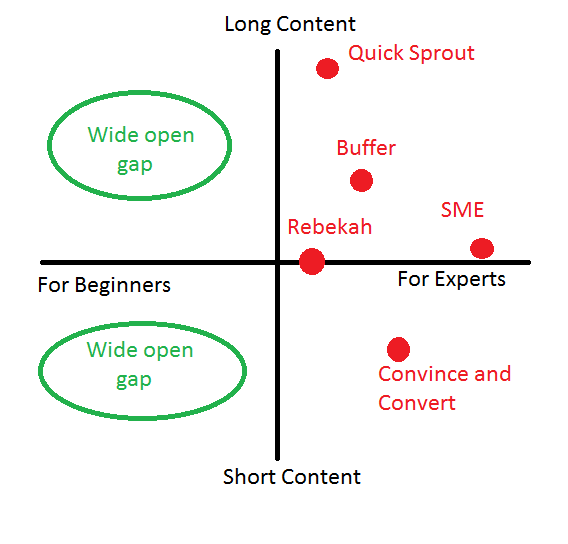
Ideally, you’ll spot at least one open space.
Maybe there’s room for long-form beginner content—or short pro-level tactics.
That’s your initial position.
If no gaps appear, pick two different differentiators and repeat. In most sizable niches, whitespace exists—you just have to choose the right axes.
Step #4 – Kickstart your audience (before you blog consistently)
Now that you’ve defined your position, you’re ready to blog, right?
Not so fast.
If you publish to an empty room, even great posts won’t move the needle.
Promotion works far better when some readers already show up.
So what do you do first?
Go where your audience already hangs out online and bring them back to your site.
Then you have two immediate goals:
- Publish one or two truly outstanding posts, then invite readers to join your email list
- Or send traffic to a focused landing page with an irresistible lead magnet
The idea is to collect a few hundred regular readers before you shift into a steady publishing cadence.
With that base, new posts get shared more, and growth compounds faster.
During this jumpstart phase, prioritize high-leverage tactics—ways to attract hundreds of the right people quickly.
Two proven paths work well.
High-growth tactic #1 – Guest posting: Find the blogs your readers already frequent and contribute there.
Pitch topics aligned with your positioning so the readers who love that post are the exact people you want on your list.
High-growth tactic #2 – Paid acquisition: If you prefer speed and have a budget, run paid traffic to your best post or lead magnet.
After some iteration, it’s common to acquire subscribers in the $1–3+ range depending on audience, channel, and offer—enough to build a 500–1,000-person list for $500–$3,000.
The timeline can be measured in weeks, not quarters.
Step #5 – Grow 5–15% monthly with consistent publishing
Once you have an initial audience, steady publishing on your own site can drive 5–15% growth per month.
That may sound modest, but compounding makes it powerful.
Here’s a simple projection: start at 500 readers and grow 10% monthly for two years.
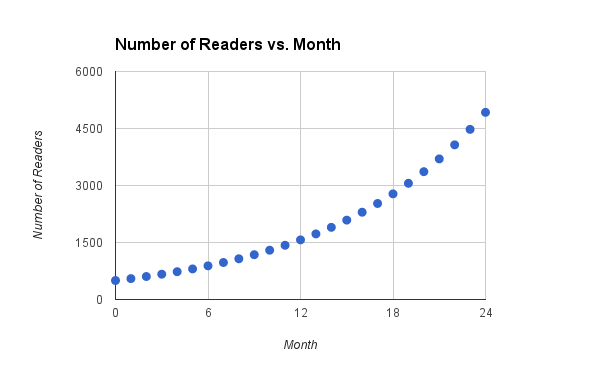
After two years, you’re at ~5,000 readers—a solid audience by any standard.
And you might exceed that—these targets are deliberately conservative.
So aim for 5–15% and focus on the system that produces it.
How?
There are three parts.
Part #1 – Build a content idea bank: To publish consistently, stockpile topic ideas that your audience actually wants.
Ahead-of-time brainstorming prevents last-minute scrambling and helps you plan series, internal links, and assets your readers can reuse.
Collect enough ideas for at least 2–3 months. If you get stuck, try these:
Part #2 – Set a sustainable calendar: Once you have ideas, decide how often you’ll publish—and stick to it.
We publish multiple times per week—that’s aggressive.
If that pace isn’t realistic, go weekly or twice a month. Consistency beats intensity.
Put posts on a simple content schedule so your plan is visible.
It doesn’t need to be fancy. A spreadsheet works fine.
Part #3 – Keep a direct line to readers: You need an owned way to reach your audience.
Even great content gets forgotten without reminders.
Email is still the most reliable channel. Start your list on day one and nurture it.
Build a secondary presence on one social platform if you like—but treat it as a bonus, not your primary channel.
Step #6 – Let your audience shape products they’re eager to buy
With a few thousand subscribers who trust you, you’re ready to generate product ideas the market will welcome.
Because you understand your readers better than anyone, you’re well-positioned to build something superior.
And because there’s a relationship, people will try your product and give you feedback that makes it better.
Three practical ways to source winning ideas:
Option #1 – Pitch product ideas to your list: You probably have 5–10 ideas already.
Validate them by sending small-batch pitches to subscribers to gauge interest and pre-orders.
Bryan Harris at Growth Tools (formerly VideoFruit) shared a behind-the-scenes breakdown of doing exactly this.
Bookmark it for later—here’s the short version.
He drafted a simple proposal for a course:

Then he emailed 50 subscribers—not the whole list.
No need to blast everyone with an unproven idea.
Here’s the simple outreach he used:

Repeat this with multiple ideas and multiple 50-person cohorts.
If pre-orders trickle in, increase the cohort size to confirm demand.
In his case, he sent to groups of 50, then 75, then 100.
Out of 225 people, 39 pre-ordered—strong validation.
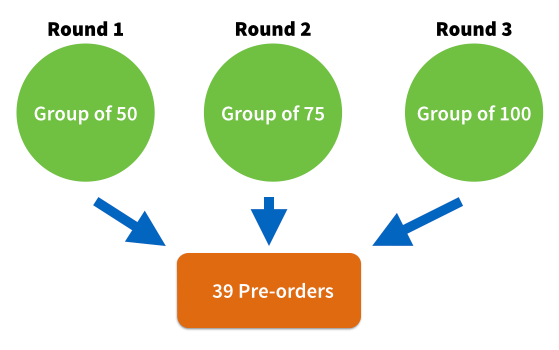
When he launched to the full list, results followed—as expected.
Option #2 – Survey your readers: Surveys help you discover persistent problems and willingness to pay.
Pair survey insights with pitches or interviews to choose the right solution.
Option #3 – Listen to comments and replies: Your audience will often tell you what they’d purchase.
For example, a reader might say they’d pay for a step-by-step process to produce professional videos without a studio:
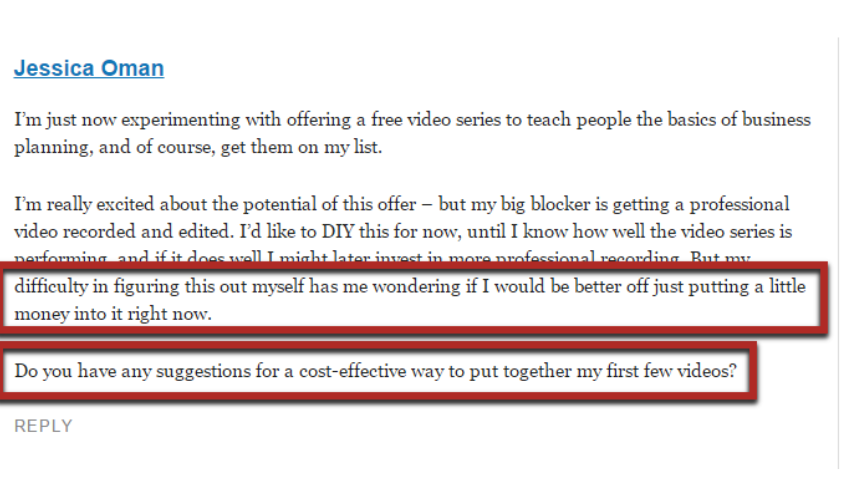
Boom. That’s a product lead. If you see the same request five or more times—with explicit mentions of paying—offer the solution.
Step #7 – Turn loyal readers into happy buyers
With a validated product, it’s time to sell it to your audience.
You don’t need a hyper-aggressive pitch. The relationship you’ve built does a lot of heavy lifting.
Beyond a straightforward email sequence, webinars work especially well for higher-priced offers.
Adweek has an extensive webinar library worth browsing for format ideas and inspiration.
Teach something genuinely useful related to your product, then make a clear, low-pressure offer at the end.
Well-executed webinars can convert in the 10–20% range with a warm audience.
Conclusion
You can build a product first and then go find customers.
Or you can flip the script and build the audience before you sell.
When you grow an audience first, you earn trust, uncover real problems, and ship products people already want.
That’s how you reduce risk while earning stronger conversion rates and faster sales at launch.
You now have a seven-step plan to build a business by starting with your audience. The next move is yours—pick a niche, validate demand, and publish your first piece this week.
